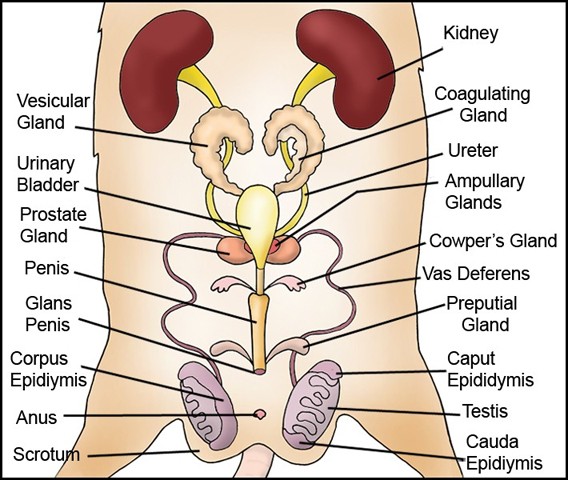The primary functions of the male reproductive system are the production of sperm, the transportation of sperm from the testes out of the male body, the placement of sperm into the female’s vagina, and the production of glandular secretions and hormones.
Sperm are produced in the testes and then are transported by a series of ducts until they exit the penis via the urethra.
Reproductive organs

Testes
The size of the testes in relation to the rat’s body weight will vary between individuals. However, within mammals, the size increases when the mating habits are more polygamous than monogamous. With rats, the testes are larger due to their polygamous mating habits.
The testes (singular: testis) are contained in two separate membranes called scrotal sacs. In a young rat they descend between 4-6 weeks of age.
Throughout the rat’s life the testes are able to move up into the rat’s abdominal cavity as a result of the feature of the rat having an open inguinal canal.
Spermatogenesis (formation of sperm) occurs in the epithelial lining of the seminiferous tubes found within the testes. Another role of the testes involves the secretion of steroidal hormones such as testosterone, estrone, and progesterone.
Epididymus
The testes are partially covered by the epididymus which consists of 3 regions: the caput epididymus (located at the top), the corpus epididymus (running down one side), and the cauda epididymus (the portion at the bottom of the testes).
The caput epididymus is enveloped in fat and leads into the ductus deferens. The epididymus stores the sperm that have been manufactured within the testes.
Vas deferens (Ductus Deferens)
The vas deferens are long tubular structures in the inguinal canal that run from the epididymus to the urethra. They carry the sperm to the penis.
Penis
The penis pushes urine and semen through the urethra and out of the body.
Male rats have an os penis also termed the baculum. The os penis is a single cartilaginous structure (penile bone) that supplies the rigidity for copulation. The word baculum means “stick” or “staff” in Latin.
The penis is sheathed by the prepuce. The outer surface of the prepuce is skin and the inner surface is mucosal membrane. The preputial sac contains desquamated squamous epithelial cells similar to other mucosal cavities such as the oral cavity or vagina. This white, creamy material may collect under the prepuce of the penis and is called smegma.
The prepuce fits snugly around the penis and protects it from friction, debris, bacteria, and injury.
Accessory Glands
The male rat has 5 pairs of accessory sex glands. The secretions of these glands serve to nourish and activate the sperm, to clear the urethral tract prior to ejaculation, serve as a means of transporting the sperm in the female tract, and to create a copulatory plug to help ensure fertilization.
-
Vesicular & Coagulating glands
The rat has two vesicular glands. These glands are located behind the urinary bladder and curve in towards the each other.
The side of the glands facing each other is where the coagulating gland is located. Each one of these glands has a duct that joins with the vas deferens to form an ejaculatory duct. This duct empties into the urethra.
The vesicular glands produces a fluid that contains fructose (an energy source for the sperm), as well as secretions that contribute to the mobility and viability of the sperm.
Both the vesicular glands and the coagulating gland secrete fluids that form the copulatory plug. -
Cowper’s Glands (Bulbourethral Glands)
The Cowper’s glands, also known as the bulbourethral glands, are made up of multiple lobules that secrete a pre-ejaculatory, or Cowper’s fluid, into the urethra during sexual arousal.
This secretion serves to clear the urethra of urine and to lubricate it and the vagina. The product may also serve as an energy source for the sperm.
-
Preputial Glands
These are small sebaceous exocrine glands (glands that do not secrete directly into the blood stream). The preputial glands are located towards the end of the prepuce (the sheath that covers the penis) that secrete smegma.
Smegma is composed of oils, moisture, and shed epithelial cells. It moisturizes the glans and in a healthy rat has antibacterial and antiviral properties. Smegma can however form a proteinaceous plug , otherwise termed “penis plug” , that can interfere with urination and/or lead to infection if not removed.
-
Prostate Glands
The prostate gland is a dense gland located behind and slightly below the urinary bladder and is partially wrapped around the penis.
The prostate glands produce most of the fluids found in semen as well as the fluid that transports the sperm through small ducts to the urethra. This fluid is released through the penis during ejaculation.
References
- Baculum. (n.d.). Retrieved December 17, 2008, from http://en.wikipedia.org/wiki/Os_penis.
- Cold, C., & Taylor, J. (1999). The Prepuce. BJU Int, 83 Suppl.(1), 34-44. Retrieved December 17, 2008, from http://www.cirp.org/library/anatomy/cold-taylor/.
- Muskopf, S. (n.d.). Rat – Urogenital System. Retrieved December 17, 2008, from http://www.biologycorner.com/bio3/anatomy/rat_urogenital.html.
- Simmons, K. (2005, February 21). Rat Reproductive System. Retrieved December 17, 2008, from http://io.uwinnipeg.ca/~simmons/16labman05/lb8pg8.htm.
- Suckow, M., Weisbroth, S., & Franklin, C. (2005). The Laboratory Rat, Second Edition (American College of Laboratory Animal Medicine). Toronto: Academic Press.
Male Reproductive Diagram by Joanne “Bella” Hodges


